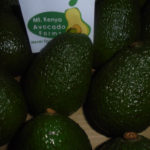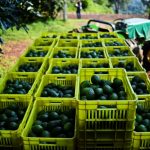 Shipping Kenya “alligator pears” today? As you will find out in the next few lines, this is a process that begins way before the actual sea or air journey. Indeed, the secret to fresh avocados upon arrival is the careful selection and preservation right after harvesting. This continues through the shipping journey and then the grocers take over from there and continue with refrigeration. But before delving into the topic, here are some few recent updates on local avocados.
Shipping Kenya “alligator pears” today? As you will find out in the next few lines, this is a process that begins way before the actual sea or air journey. Indeed, the secret to fresh avocados upon arrival is the careful selection and preservation right after harvesting. This continues through the shipping journey and then the grocers take over from there and continue with refrigeration. But before delving into the topic, here are some few recent updates on local avocados.
In early 2018, Kenya banned the export of avocados to recover dwindling local supplies and help meet international standards.
In March of the year, the country lifted the ban of fuerte and hass exports to the relief of farmers and traders.
By April and May 2018, small-scale farming communities in the Rift Valley were partitioning parts of their maize fields to plant new found gold-avocados. Some family growers in Kericho had already received over 2000 seedlings on May 9, 2018 from their county representative from the Kapsoit ward.
With the above updates in mind, it is clear that understanding shipping matters now more than ever especially for newcomers in the field. The following therefore highlights the procedure from harvesting to post-delivery overseas of this tropical fruit.
At least four days provide enough grace period between harvesting and packing for most international shippers of avocados. These four days are often constituted as a part of the long-distance journey awaiting the cargo.
It all begins with plucking off the fruits from their high placement on the ten meter-high tree. Poles with clippers at the end are best for fast harvesting as they entrap each fruit cup-like.
Then the collection of the avocados into baskets follows under a shaded area ready for conveyance to the cooling room. The low temperatures in the warehouse keep the fruits fresh during the brief period of sorting and packing.
The initial step after the delivery of the fresh fruits into the warehouse is to cool them using hydro-cooling mechanism. Night time cooling when the temperatures are already naturally low removes much of the field heat.
The next part of the warehousing stage of Kenya avocados is sanitization. This involves the washing of the fruits in troughs where clear water runs through. Workers also note any spots on the skin and remove them to make the fruits presentable.
To know which avocado is suitable or not to shortlist into the package, keep the following in mind: the fruit should weigh approximately 0.4 kilos and reach about 10 centimeters in length. Though it requires extra measurement, a healthy fruit has at least 15 percent of oil content. In appearance, the fruit ought to be firm, slightly pear in shape, rough-skinned and greenish-colored, just verging on the eventual black or brown tinge.
If grading the fruits, there are three guidelines to follow: uniformity of all samples, color, and the level of ripeness. The first grade thus constitutes similar-sized fruits (medium to large) which are greenish-brown colored and are firm.
Packing then follows where the fruits feature in small cartons that some call lugs or tray packs and others, pellets. Either way, the cartons must be functional enough to offer a tight pack that prevents friction, shaking and movement so as to reduce skin injuries during transportation.
There are also bulk packing crates that shippers also allow especially when there are multi-ton deliveries. For this kind of packing, it is necessary to ensure that only the unripe, firm and large avocados are present as they are less susceptible to bruises than small and weak ones.
After checking that all fruits are well-sealed and labeled in their tray packs, it is then time to transport the Kenya avocados to the harbor or airport. The use of refrigerated vans necessitates no use of ice on the boxes. This is because the controlled temperature environment inside the vehicle is sufficient to keep the fruits fresh.
Avocado transportation by surface means differs from one part of the world to the next. Tropical avocados from Kenya, for instance, need overland temperatures of 7.2 to 12.8° Celsius. This is slightly higher than their onboard ship temperatures. Those from the West Coast of the United States, on the other hand, require chilling overland transportation temperatures of as little as 3.3°C.
It is also important that tropical avocados are conveyed to the port at relative humidity of 85 to 90 percent. The oxygen allowance should be 5 percent and that of carbon dioxide double that percentage.
Combining optimum overland transportation temperatures with the controlled atmospheric conditions of the sea or air transport gives the fruits more than 6 weeks lease of life. This is two weeks more than the shelf life of avocados that are preserved only during shipping.
Handling the avocados at the Mombasa port or airport in Nairobi should best take place under dry conditions: if it is raining, then polythene covers are necessary to prevent early deterioration due to dampness.
Stowing should be by manual means whenever possible to prevent machine injury. For bulk stowing, it is important to keep 3.12 meters cubic of bulk crates per shipment container weighing one ton. Padding the crates where they come into contact with transportation pallets is also essential.

Packed avocados [Getty Images]
At the port, avocado shippers can decide to either include ice on the boxes or not. This depends on the availability of freezers inside the air or sea vessel. If refrigeration is available, then one forgoes ice but if it is not accessible, the placement of dry ice on top of the packs is essential.
Storage temperatures during shipping are telltale signs of how the avocados from Kenya will reach their destination. The unripe, firm, Grade 1 fruits store best at between 8 and 12° Celsius. They are suitable to keep for a whole month (approximately 28 days) unspoiled.
If by any chance there are slightly ripen avocados on board, then their storage temperature should be no more than 8° Celsius and no less than 5° Celsius. The upper limit prevents dehydration while the lower shelf keeps off chilling injury.
The relative humidity for the fruits, whether ripe or dry should be quite high at 90 percent. This way the ripe ones can keep for a minimum one week unspoiled and maximum two weeks.
The other aspect of onboard handling of Kenya avocados on board the ship or aircraft hold requires careful space consideration. This is aimed to keep pressure and shaking as low as possible. It is therefore a recommendation to tightly position the containers on the hold for a pressure-free trip.
Even when maintaining this tight formation, the ventilation must also go into consideration. Air circulation should be proper enough to balance oxygen and carbon dioxide parameters.
Ideally, 60 to 80 circulations each hour is essential for a fresh arrival premise of the fruits. This helps to maintain a balance of carbon dioxide and ethylene. If the gases go into excess, they may lead to fast ripening on board.
The maximum levels of carbon dioxide concentrations in the avocado hold should be 3 to 10 volume percentage. The best figure for the freshest arrivals should be as low as 0.49 volume percentage. If it goes above the former peak, it may have similar effect of a charcoal brazer left burning overnight in an unventilated room for a person sleeping inside. Though it may not severely damage the avocados, it may be toxic to people who enter the hold.
It is also essential to keep avocados in separate containers from other fresh produce to avert contamination from gases. This precaution particularly applies to bananas which produce latex, a liquid that comes from fresh cut bananas and may induce ripening.
In short, proper ventilation ensures that the avocados do not ferment, rot or lead to immature ripeness. Like other living things, the fruits constantly release gas, moisture and any field heat that hydro-cooling may not have removed completely. With optimal air circulation, these emissions will not adversely affect the cargo.
Some of the often overlooked tidbits that might have overall implication on the safe arrival of the avocado cargo is the cleanliness of the containers. By nature, this fruit is averse to any dripping oil: so the container should have no sign of gasoline. Secondly, the fruit’s naturally neutral, pleasant smell keeps well as long as there are no other smells around: so, keeping odorous fresh produce like onions, garlic and bananas away may do a favor to the ‘alligator pear.’ To cap it all, the container ought to be thoroughly clean as this way it keeps off dusty conditions which worsen the fruit’s condition.
Upon arrival in a matter of days or weeks by sea or within a day by air depending on the destination, Kenya avocados may still not be ripe. The grocery stores may not tamper with the fruits as they need to sell them fresh but those bound for wet markets need artificial ripening.
Artificial ripening requires ethylene, which fastens the process of flesh softening. The fact that the avocado continues to excrete natural ethylene during respiration is the reason it responds quite well to artificial ripening by the same product.
The forced air treatment with the gas depends on the current degree of ripeness of the fruit and the source. Tropical fruits ripen fast and thus may require as minimal as 10 parts per million (ppm) of ethylene dosage. For the still green avocados, a dose of around 20 ppm can work but the maximum to use should be less than five times this level.
Most warehouses that receive unripe avocados in Europe and the United States keep a weather eye on the fruits during this induced ripening period. This is because most of the fruits are of mixed maturity periods and come from different sources, which means some ripen faster than the others.
Tropical avocados from Kenya may require as little as 1 day of forced ripening to take effect. Those from California as they come from cool conditions may take some days or even weeks to ripen.
Avocados from Kenya that arrive in Europe are mainly of the hass variety. They are preferably sizes sixteen to twenty. Fuerte is however the exporters’ delight for lands like the Middle-east where all sizes, particularly 14 and 16 are acceptable. Both types are in use as raw fruits while at other times as processed products. Extra virgin avocado oil, soap, guacamole and other products are some of the by-products that processors make in these destinations.
Because of the sharp curating in these international markets especially Europe, Kenya avocados normally meet the following conditions: a dry matter degree of 23 percent. This averages around 21 percent for hass as well as 20 percent in terms of fuerte. This strict observance may be absent in other markets in the Middle-east and Asia.
There are at least three classes of avocados that are namely Class I, II and Extra Class. These grades indicate the quality levels of the fruits.
In short, the shipping process of avocados especially from Kenya is a tedious but eventually rewarding experience. Right from the hard work of plucking the ‘alligator pear’ from some eight meters above the ground to eventual sorting, the early processing requires concentration. The packing, transportation and handling in readiness for shipping also involves industry standards’ adherence. Shipping and arrival require atmospheric conditioning for both storage and market ripening needs. Thus, it is quite some process!
References
http://ucce.ucdavis.edu/files/datastore/234-1569.pdf
https://www.hunker.com/12383170/how-to-ship-avocados
https://www.nation.co.ke/business/Avocado-production-set-to-boom/996-4547562-121nys6/index.html
http://www.tis-gdv.de/tis_e/ware/obst/avocado/avocado.htm
http://www.avoco.co.nz/vdb/document/61
https://www.cbi.eu/market-information/fresh-fruit-vegetables/avocados/europe/

